ORDER
Passeriformes
FAMILY
Paridae
GENUS & SPECIES
Parus atricapillus
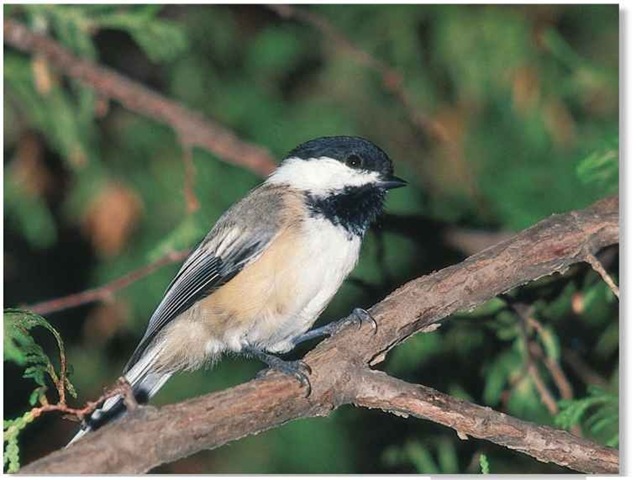
Has an extensive vocal range, which includes at least 15 calls and songs t Diverts and evades predators by “throwing its
voice” as it calls t Families continue to forage together even after
chicks have fledged
where in the world?
Found across most of the United States and part of Canada from central Alaska to Newfoundland, south to North Carolina
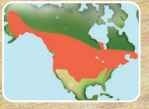
LIFECYCLE
With its complex range of calls, the black-capped chickadee is able to communicate a wide range of messages, from warnings to mating songs.
HABITAT
The black-capped chickadee favors edges of deciduous, mixed and coniferous forests, gardens and parks. Depending on the species, the bird can be found at high and low elevations. It occurs in the spruce fir forests in the Adirondacks in New York and pinyon-juniper forests in Colorado. Other favorite habitats include riverine willows, cottonwoods, alders, well-wooded farmland and cemeteries. In the winter and during migrations, the bird may be found in a wider variety of bushy habitats, including urban areas and among conifers. Due to fear, it usually avoids crossing open bodies of
water when it migrates. Some mountain populations of the bird will change elevations depending on food availability and the weather. The chickadee is also found at higher elevations in the Appalachians, the Great Smoky Mountains and the Rocky Mountains.
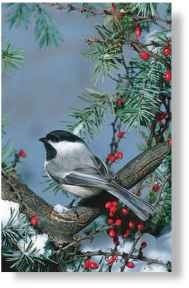
A Braving the cold The chickadee remains in some areas year ’round.
| # The black-capped | Along with the great tit, |
| chickadee is able to | the black-capped chickadee |
| retrieve stored food items | is one of the most-studied |
| up to one month after | birds in the world. |
| hiding the food. | Only birds have a syrinx, |
| Chickadees are able | a specialized voice box; it |
| to fly even after lowering | sits lower in the body and |
| their body temperature. | aids in balance during flight. |
BEHAVIOR
Flocks of black-capped chickadees consist of about 2-18 birds.They brave the cold of winter by shivering, which helps turn body fat to energy keeping the birds warm. This hardy bird also conserves energy in temperatures far below freezing by lowering its body temperature and burning fewer calories.Throughout the year, flocks will often join together and fly with other similar bird species, such as warblers and creepers, in search of food.Vocalizations serve to ensure the safety of the group. Some members of a feeding flock will keep an eye out for danger, and the first chickadee to spot a potential predator gives a warning note. In response, the whole flock freezes and utters thin, ventriloquial calls, which sound as if they are coming from another area.This confuses the predator; and most will then leave.When the coast is clear, and all is well, a chickadee call brings the flock back to life. Other birds also benefit from this defense system. Though often tame to the extent of being hand-fed, the black-capped chickadee remains secretive in its family life, from egg-laying to fledging, but its seet-seet-seet and zee-zee-zee calls are heard throughout the breeding season.
CONSERVATION
The black-capped chickadee is fairly common throughout its expansive range, with upward population trends recorded in its eastern range, as well as periodic fluctuations peaking every 2-3 years across the southern U.S.The presence of suitable nesting sites is always a limiting factor within any habitat.
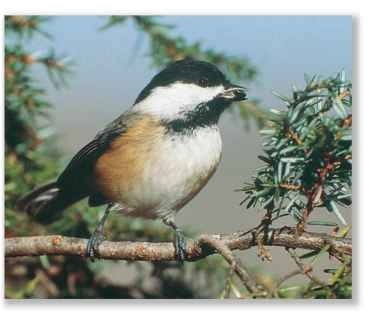
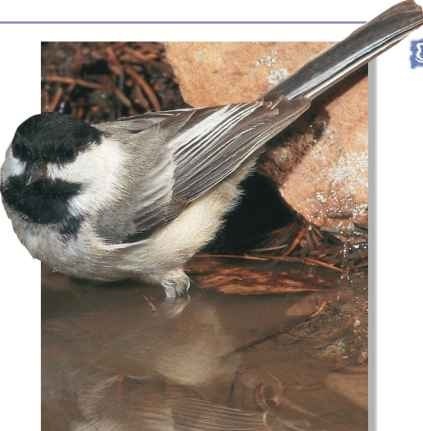
A Kiddie pool
The tiny black-capped chickadee doesn’t have to search far for a shallow pool of water to bathe in.
FOOD & FEEDING
Almost all the nourishment the black-capped chickadee needs can be found in trees and shrubs. Feeding primarily on insects, seeds and berries, the chickadee uses its pointy beak to pluck at the bark of trees or tug at branches.The bird favors caterpillars and spiders, as well as hemlock and bayberries, and may also feed on maple sap, the fat of animal carcasses or dead fish.The birds often carry larger food items to their roost before eating, often stashing them for the winter among pine needles and in tree holes. Finding food in the winter is difficult for this tiny bird; foraging in groups increases the chance of success. The birds keep an eye on each other; when one finds a morsel, the others renew their search in that area. New food sources are continually Bountiful berries communicated throughout the flock The chickadee enjoys either through calls or direct the seasonal treats. observation of captured items.
BREEDING
Pairs mate for life and begin their breeding cycle in Apri when the winter flocks disperse; territories are established using fee-bee calls. The birds build their nest in a rotting branch, usually in a birch or aspen tree, I-10′ above ground. Both sexes excavate the nesting hole, but only the female builds the nest inside, which
she lines with grasses, pine needles, fur and spider webs. She incubates the 5-10 brown-spotted white eggs for 11-13 days; her mate feeds her while she remains in the nesting chamber. The new chicks fledge after 14-18 days but still join their parents in search of feeding grounds. Single families often join up with one or more families, forming flocks of 8-12 birds, during the fall and winter months. Families break up during the following breeding season, and young chickadees finally disperse from their birth areas, often moving several miles away.
and babies make five
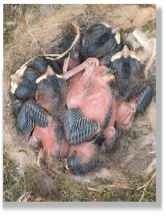
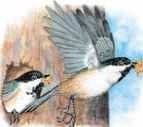
1 Teamwork…
A pair excavates a nesting hole in an aspen tree. One digs as the other removes wood chips.

2 Finishing touches…
The female makes herself at home in the chamber, as she lines the area with fresh green grass.
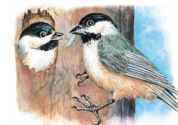
3 Hungry mate…
The male feeds the female a large caterpillar while she remains inside incubating the eggs.
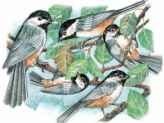
4 Family affair
The family forages together after the chicks have fledged, finding food under leaves and bark.
PROFILE
Black-capped Chickadee
Named for its cheery song and bold black cap, the sociable black-capped chickadee sings a concert of calls year-round.
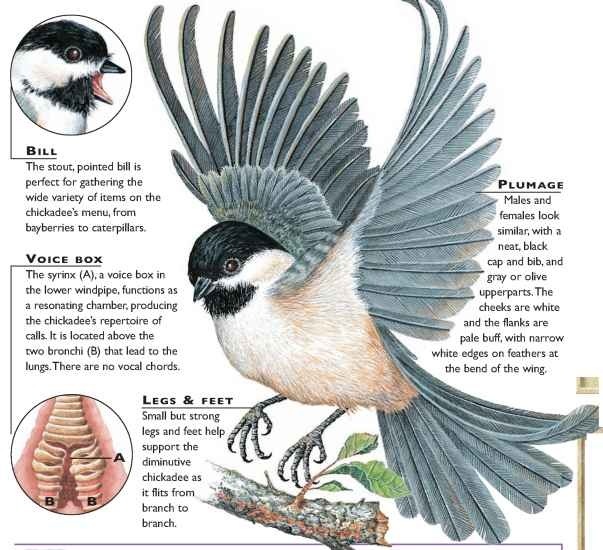
CREATURE COMPARISONS
Similar in appearance and size to the black-capped chickadee, the coal tit (Parus ater) is found in continental Europe and Asia to northeast China, far from the chickadee’s North American range. An accomplished singer; the coal tit sports a black head and bib, just like the chickadee, and its upperparts range from gray to olive, while underparts are buff to cinnamon colored with cream-colored patches. Both the black-capped chickadee and coal tit collect seeds and insects in the autumn and cache them, hiding the food in storage areas to be retrieved later in the winter.

| vital statistics | |
| Weight | About 0.3 oz. |
| Length | 4.75-5.5″ |
| WlNGSPAN | 7.5-8.5” |
| Sexual Maturity | About 1 year |
| Breeding ; Season | April-June |
| Number of Eggs | 5-10, usually 6-8 |
| Incubation Period | 11-13 days |
| Fledging Period | 14-18 days |
| Typical I Diet | Insects, seeds and berries |
| Lifespan | 12 years or more |
Related species
• The black-capped chickadee’s genus, Parus, includes the boreal chickadee, P. hudsonicus, and the Carolina chickadee, P. carolinensis. They join over 60 species of titmouse, bushtit and chickadee in the family Paridae. The subfamily Parinae, which contains mostly cavity nesters, includes the largest member of the family: the 8”-long sultan tit, Melanochlora sultanea.
